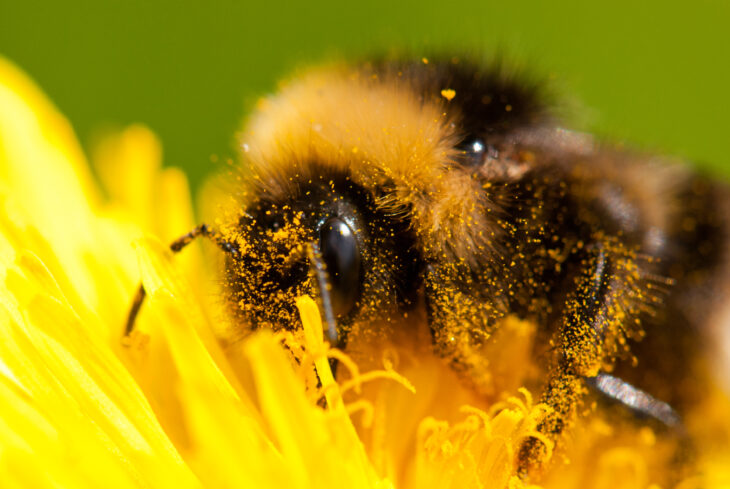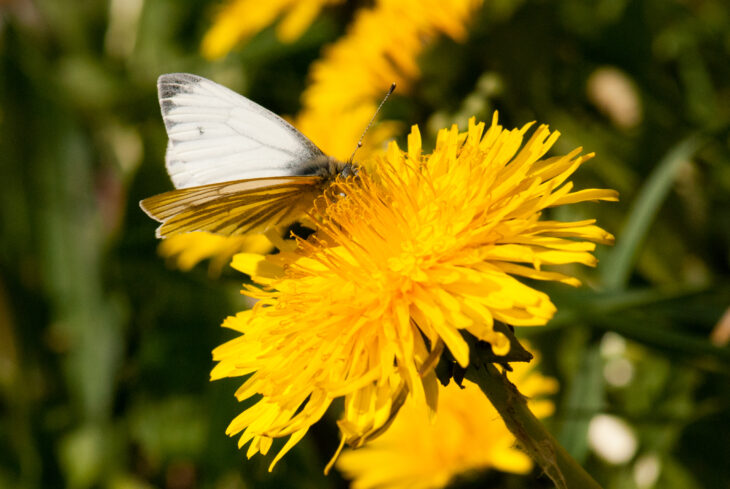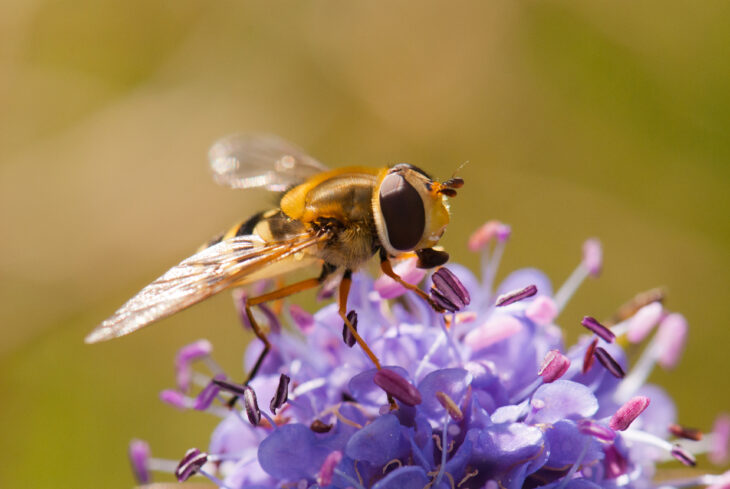The Apocalypse of Small Things

Discussions of wildlife losses often concentrate on the relatively big things, from red squirrels to wildcats, and the picture that paints is worrying enough. But according to new, comprehensive research, evidence of an ongoing mass extinction is best found under the magnifying glass – and the way we produce food is deeply complicit, and itself imperilled.
The worldwide decline of invertebrates, or entomofauna, is the most dramatic trend of what scientists are already calling the sixth mass extinction (e.g. Barnosky et al, Ceballos et al). And the UK is, overall, seeing the most significant of those declines in all the countries studied in a just-published, global report.
Coming soon after a devastating report last year that found humanity has wiped out a staggering 60% of mammals, birds, fish, and reptiles since 1970, the new report “highlights the dreadful state of insect biodiversity in the world, as almost half of the species are rapidly declining and a third are being threatened with extinction”. For a scientific publication, its language is stark, and its implications severe.
What did insects ever do for us?

Insects are the heart of global food webs and ecosystems. They’re essential in the recycling of nutrients, in pollinating plants, and as food for countless vertebrate species. The decline of insect populations and species is of enormous concern more generally, as the authors point out: “Species extinctions equally impact the overall biomass of entire ecosystems, as insects form the base that supports intricate food webs. Indeed, the essential role that insects play as food items of many vertebrates is often forgotten.”
Because of the deep interconnection, evidence of insect decline is beginning to change our understanding of declines in other species. As the authors of the new research highlight, “If this food source is taken away, all these animals starve to death”.
We know we only have 60-100 harvests remaining in our soils. Our current pursuit of food is threatening our ability to produce food in the future. What we’re seeing is a perfect storm of different environmental crises compounding one another. It’s beginning to challenge popular perceptions of where harm occurs, and what is protected: research in Germany showed that 75% of insect losses occurred in protected areas. The way that certain pesticides disperse and persist in the environment means the problem can only be tackled at source.
We can’t underestimate the problem of a collapse of invertebrates, and what this would mean for the survival of total ecosystems, ourselves included. What threatens these populations is global in scale, but local in character – the use of pesticides and land-use change. We need an intergovernmental forum, but we also need local and national action.
Pesticides is a catch-all term referring to fungicides, insecticides, herbicides, and so on – a human-made chemical applied to minimise or remove a perceived pest, usually from managed land. Pesticides are applied in the greatest quantities in agricultural lands, where they’re used to protect or favour crops from predation or competition. Other land uses, such as golf courses, can use large quantities of pesticides.
Scottish agriculture uses around 1700 tonnes of pesticides each year, while a growing amount of evidence has linked pesticide use to dramatic declines in invertebrates, with knock-on effects throughout the food web and ecosystem.
The EU has tried to address the environmental problems caused by pesticide use through a Directive (Sustainable Use of Pesticides), which member states were required to implement in 2014. Directive 2009/128/EC sets out rules for the sustainable use of pesticides to reduce the risks and impacts of pesticides on the environment. Actions to be taken by member states include producing national action plans on cutting pesticide use, fostering the use of alternative ecological approaches or techniques and promoting low pesticide-input management (integrated pest management – IPM) including non-chemical methods.
The Scottish Wildlife Trust champions the case for integrated pest management and land stewardship, so that we can feed ourselves now without imperilling food production in the future, while ensuring ecosystems can recover.
What can we do about it?
There are everyday things we can all try to do as well – buying organic produce where and when we can; insuring our gardens are free of pesticides; building insect hotels from renewable and recycled materials; and campaigning for greater native biodiversity in our parks. But we shouldn’t rest there – organic food is more expensive while more environmentally-damaging foods are cheaper, many of us live far away from recreational areas and feel disconnected from nature. These are systemic issues, they require a systemic response.
We’ve campaigned for years for a sustainable food and farming system. And many farmers and crofters have been on the frontline of driving this change.
As corresponding author, Dr Francisco Sánchez-Bayo, told me: “the problem should be tackled within the agricultural organisations, as they are the ones that need to change their ways of producing food.”
“Really, when we know that agricultural intensification, and associated overload of pesticides and fertilizers, is the main driver of the declines and responsible for the widest contamination of our environment, the solution must be found in there.”
What this means is change must come from the production side; responsibility can’t just be lumped on consumers.
The Scottish Wildlife Trust, together with our partners in Scottish Environment LINK, have been trying to ensure our farming and food systems evolve to counter this and other fundamental threats. While political leadership remains fractured by Brexit, the UK’s withdrawal from the Common Agricultural Policy (CAP) presents opportunities for truly progressive action on sustainable land use in Scotland. Human-caused climate and environmental change continue to pose grave threats to our biodiversity, while our worsening ecosystem health makes us more vulnerable to those changes, and less able to adapt to them.
The Common Agricultural Policy (CAP) is the EU’s farm subsidy system. CAP promoted food production in post-war Europe, but this came at significant financial and environmental cost. At its peak the CAP cost 73% of the EU’s budget and still accounts for 38% of total spend and provides nearly half of farm income. This provides essential funds to keep many farms afloat, but as Bateman and Balmford point out, the “bulk of its funds are paid through the Pillar 1 Basic Payment Scheme. However, because this is allocated on a per hectare basis this means that three quarters of these funds go to just one quarter of farms”. Scotland has historically benefited far less from what farmers often decry as an overly complicated system.
More importantly, the subsidy system has encouraged excessive production: that means the public has subsidised over production and food waste. What’s more, because the CAP is publicly funded and subsidises private goods (food products), the public pays twice for these goods – first through taxes, and then through the cost of the goods in the store. The Scottish Wildlife Trust, together with 35 environmental organisations and a host of farming networks want to see this system overhauled as we leave the EU. We want to see a system that supports farms for doing environmental good – protecting species, storing carbon, testing soils, reforesting areas, and better integrating natural processes into farming practice.
Read more here.
Alongside our calls for integrated land stewardship – working with natural processes rather than against them – we need integrated pest management to be far more widely adopted. The Scottish Wildlife Trust has previously set out what can and should be achieved in Scotland to start addressing this crisis, and integrated pest management (IPM) is part of our vision.
Scotland’s farmed land would have to change to become more wildlife friendly in order to encourage natural predators and parasites of crop pests back into the agricultural landscape… such habitat changes would also create more attractive places to be and allow for more frequent encounters with nature. 50 for the Future >
At present, there are “legal requirements to take ‘reasonable precautions’ to protect human health and the environment when using or permitting the use of pesticides”, but adopting an IPM Plan is voluntary. In fact, the industry works hard to ensure that this remains self-regulated and voluntary, rather than mandatory and regulated by a competent authority.

We can’t ignore our own consumption behaviours, but we also can’t pretend that this is where the ultimate solution can be found. How we produce and consume food, including legislation on the right to food, is becoming a part of the national discussion, and there’s still time to have your say here. You can find a great guide to responding to the Good Food Nation Bill here. Tell the Scottish Government that any food system must be sustainable – it must ensure that feeding ourselves now will not starve future generations, or the countless other species dependent on insects.
Scott Leatham
Policy Specialist
Help protect Scotland’s wildlife
Our work to save Scotland’s wildlife is made possible thanks to the generosity of our members and supporters.
Join today from just £3 a month to help protect the species you love.
Preface
Discussions of wildlife losses often concentrate on the relatively big things, from red squirrels to wildcats, and the picture that paints is worrying enough. But according to new, comprehensive research, …
